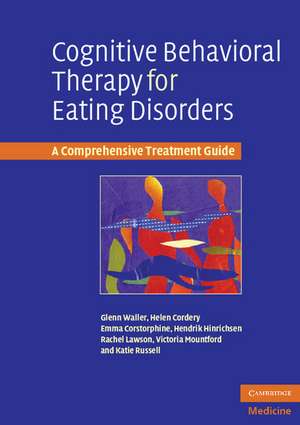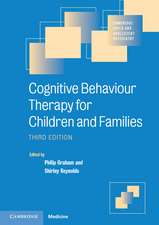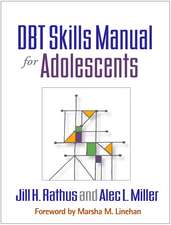Cognitive Behavioral Therapy for Eating Disorders: A Comprehensive Treatment Guide
Autor Glenn Waller, Helen Cordery, Emma Corstorphine, Hendrik Hinrichsen, Rachel Lawson, Victoria Mountford, Katie Russellen Limba Engleză Paperback – 11 apr 2007
Preț: 845.94 lei
Preț vechi: 890.46 lei
-5% Nou
Puncte Express: 1269
Preț estimativ în valută:
161.89€ • 175.79$ • 135.99£
161.89€ • 175.79$ • 135.99£
Carte tipărită la comandă
Livrare economică 22 aprilie-06 mai
Preluare comenzi: 021 569.72.76
Specificații
ISBN-13: 9780521672481
ISBN-10: 0521672481
Pagini: 470
Ilustrații: 23 b/w illus. 16 tables
Dimensiuni: 170 x 244 x 24 mm
Greutate: 0.91 kg
Editura: Cambridge University Press
Colecția Cambridge University Press
Locul publicării:Cambridge, United Kingdom
ISBN-10: 0521672481
Pagini: 470
Ilustrații: 23 b/w illus. 16 tables
Dimensiuni: 170 x 244 x 24 mm
Greutate: 0.91 kg
Editura: Cambridge University Press
Colecția Cambridge University Press
Locul publicării:Cambridge, United Kingdom
Cuprins
Part I. Introduction: 1. The philosophical and theoretical stance behind cognitive behavioral therapy (CBT); 2. Broad stages in CBT and format of delivery; 3. What the clinician needs to establish before starting; Part II. Core Clinical Skills for Use in CBT with the Eating Disorders: 4. Assessment; 5. Preparing the patient for treatment; 6. Motivation; 7. A guide to important dietary and nutritional issues; 8. Case formulation; 9. Therapy interfering behaviours; 10. Homework; 11. Surviving as an effective clinician; 12. Setting and maintaining an agenda; 13. Psychoeducation; 14. Diaries; 15. The role of weighing in CBT; Part III. Core CBT Skills as Relevant to the Eating Disorders: 16. Socratic questioning; 17. Downward arrowing; 18. Cognitive restructuring; 19. Continuum thinking; 20. Positive data logs; 21. Behavioral experiments; Part IV. Addressing Eating, Shape and Weight Concerns in the Eating Disorders: 22. Overevaluation of eating, weight and shape; 23. Body image; Part V. When the Standard Approach to CBT Is Not Enough: 24. Comorbidity with Axis I pathology; 25. Comorbidity with Axis II pathology; Part VI. CBT for Children and Adolescents with Eating Disorders and their Families: 26. CBT for children and adolescents with eating disorders and their families; Part VII. Endings: 27. What to do when CBT is ineffective; 28. Recovery; 29. Relapse management and ending treatment; Conclusion. Cognitive behavioral therapy for the eating disorders; Appendix 1. Semi-structured assessment protocol; Appendix 2. Psychoeducation materials; Appendix 3. Food diary; Appendix 4. Behavior experiment sheet.
Recenzii
'Look no further; this cutting edge therapist guide is essential reading for all those working with eating disorders and will help from the point of referral to discharge. … I have found myself dipping into this book and using some of the CBT techniques in my own clinical practice and would highly recommend this book to all health professionals working with eating-disordered patients, including clinical psychologists, psychological therapists, CBT therapists, occupational therapists, psychiatrists, nurses, counsellors and dieticians.' Psychological Medicine
'Overall this is an excellent resource for practitioners, densely packed with information yet clear and readable with ease of reference. It definitely fulfils the intention set out in the preface to be a 'clinician-orientated tool, useful in practice'. There are helpful analogies highlighted in the text, which can be lifted and used in other contexts … It also brings together research and demonstrates how to use it in practice and there is creative use of many tools such as graphs, logs and worksheets, all of which are set out in as a photocopy resource in the back of the book. It provides a wealth of information for those who do not have a lot of experience in eating disorders and is a guide that is highly recommended and one which I will personally return to often.' Behavioural and Cognitive Psychotherapy Review
'I was completely bowled over by this book: it is wonderful. A real treasure trove of clinical wisdom, embedded in the best of the available research evidence. Commendably, although this is a multi-author book, it is written with one voice. Written in a very accessible, straightforward language and immensely well structured, it contains information that will be very useful for both the novice and seasoned eating disorder therapist. … This book will become a classic. I highly recommend it.' Journal of Psychosomatic Research
'Overall this is an excellent resource for practitioners, densely packed with information yet clear and readable with ease of reference. It definitely fulfils the intention set out in the preface to be a 'clinician-orientated tool, useful in practice'. There are helpful analogies highlighted in the text, which can be lifted and used in other contexts … It also brings together research and demonstrates how to use it in practice and there is creative use of many tools such as graphs, logs and worksheets, all of which are set out in as a photocopy resource in the back of the book. It provides a wealth of information for those who do not have a lot of experience in eating disorders and is a guide that is highly recommended and one which I will personally return to often.' Behavioural and Cognitive Psychotherapy Review
'I was completely bowled over by this book: it is wonderful. A real treasure trove of clinical wisdom, embedded in the best of the available research evidence. Commendably, although this is a multi-author book, it is written with one voice. Written in a very accessible, straightforward language and immensely well structured, it contains information that will be very useful for both the novice and seasoned eating disorder therapist. … This book will become a classic. I highly recommend it.' Journal of Psychosomatic Research
Notă biografică
Descriere
This book describes the application of cognitive behavioral principles to patients with a range of eating disorders.
















